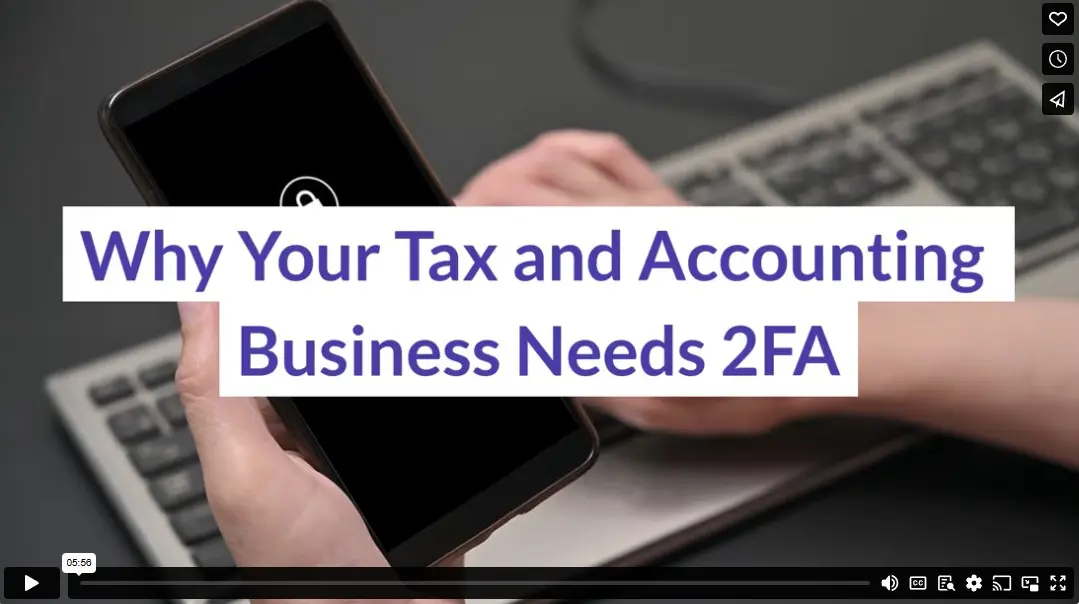Cyber threats are evolving rapidly, and accounting, tax, and bookkeeping firms make perfect targets because of the sensitive financial data they handle. Passwords alone no longer provide adequate protection for your client information. Hackers now use sophisticated methods like brute force attacks, phishing scams, and credential stuffing to break through password-only security.
Even when you create strong, unique passwords, hackers can compromise them in data breaches at other companies. Two-factor authentication (2FA) adds the critical second layer of protection your firm needs. With 2FA in place, unauthorized users can’t access your systems even if they somehow obtain your password. This can make the difference between your document management software for tax business staying safe or being hacked.
What is Two-Factor Authentication?
Two-factor authentication (2FA) is a security feature that requires users to verify their identity in two ways before gaining access to an account. Instead of relying solely on a password, 2FA introduces a second verification step, making it exponentially harder for cybercriminals to infiltrate your systems.
The most common forms of 2FA include:
- SMS or Email Codes – You receive a unique code on your registered phone or email that you must enter after your password.
- Authenticator Apps – Apps like Google Authenticator or Authy generate time-sensitive codes you enter during login.
- Hardware Security Keys – Physical devices like YubiKey require your physical presence, as you must insert or touch the key to authenticate.
- Biometric Authentication – Your fingerprint or facial scan verifies your identity, ensuring only you can log in.
How 2FA Enhances Security for Tax and Accounting Firms
As an accounting or tax professional, your firm manages highly sensitive financial data. A data breach can lead to severe financial losses, regulatory penalties, and irreversible damage to your reputation. 2FA adds an extra security layer that drastically reduces the risk of unauthorized access and data breaches.
1. Protects Against Phishing Attacks
Phishing scams trick users into handing over their login credentials by posing as legitimate emails or messages from trusted sources. Even your most cautious employees can fall for a well-crafted phishing attempt. Enabling 2FA makes stolen passwords useless, as hackers also require the second authentication to log in.
2. Reduces the Risk of Credential Stuffing
Hackers use credential stuffing attacks to test stolen usernames and passwords across multiple platforms. If your employees or clients use the same password across different accounts, a single breach can compromise your entire system. 2FA prevents attackers from gaining access, even if they have the correct credentials.
3. Strengthens Compliance with Industry Regulations
Regulatory bodies like the IRS, GDPR, and PCI DSS require accounting firms to implement strong security measures. When you enforce 2FA, you help meet these compliance standards and demonstrate your commitment to protecting client information.
If you fail to meet security requirements, you risk legal consequences and damage client trust. Implementing 2FA shows clients you take their data security seriously.
Implementing 2FA in Your Firm
Transitioning to 2FA is simpler than you might think. Most cloud-based accounting practice management software and client portals now offer built-in multi-factor authentication (MFA) settings. To ensure a seamless implementation, follow these steps:
Step 1: Identify High-Risk Accounts
Start by enabling 2FA on all accounts that store or process financial data. This includes:
- Accounting software
- Cloud storage platforms
- Client portals
- Email accounts used for financial communication
Step 2: Choose the Best 2FA Method
Select a 2FA method that aligns with your firm’s security needs and ease of use. While SMS codes are convenient, authenticator apps or security keys provide a stronger defense against SIM-swapping attacks.
Step 3: Train Employees and Clients
Educating employees and clients on how and why to use 2FA is crucial. Conduct training sessions that explain:
- The risks of password-only protection
- How to set up 2FA on their accounts
- Best practices for managing authentication codes securely
The more informed your team is, the less likely they’ll fall victim to cyber threats.
Step 4: Regularly Monitor and Update Security Settings
Cybersecurity is not a one-time task. Implement policies that require periodic security audits, password updates, and 2FA enforcement across all systems. Encourage employees to report suspicious login attempts and invest in advanced security tools that detect unauthorized access attempts.
The Future of Authentication in Accounting and Tax Firms
While 2FA is a critical step in securing your tax and accounting firm, cybersecurity is continuously evolving. Multi-factor authentication (MFA)—which incorporates biometrics, behavioral analytics, and artificial intelligence—is becoming the next standard in business security.
AI-powered authentication systems can analyze user behavior, device activity, and login patterns to detect and prevent suspicious access attempts automatically. Investing in advanced authentication measures will keep your firm ahead of cyber threats and ensure long-term data protection.
Start 2FA Today
Relying on passwords alone is no longer enough to protect sensitive financial data. Cybercriminals are becoming more sophisticated, and businesses must take proactive measures to safeguard their clients and business operations.
Now is the time to enable 2FA across your firm’s accounts. This simple step significantly strengthens your security with minimal disruption to your daily workflow. In an industry that handles sensitive financial information and remains a prime target for cybercriminals, implementing strong authentication is non-negotiable.




